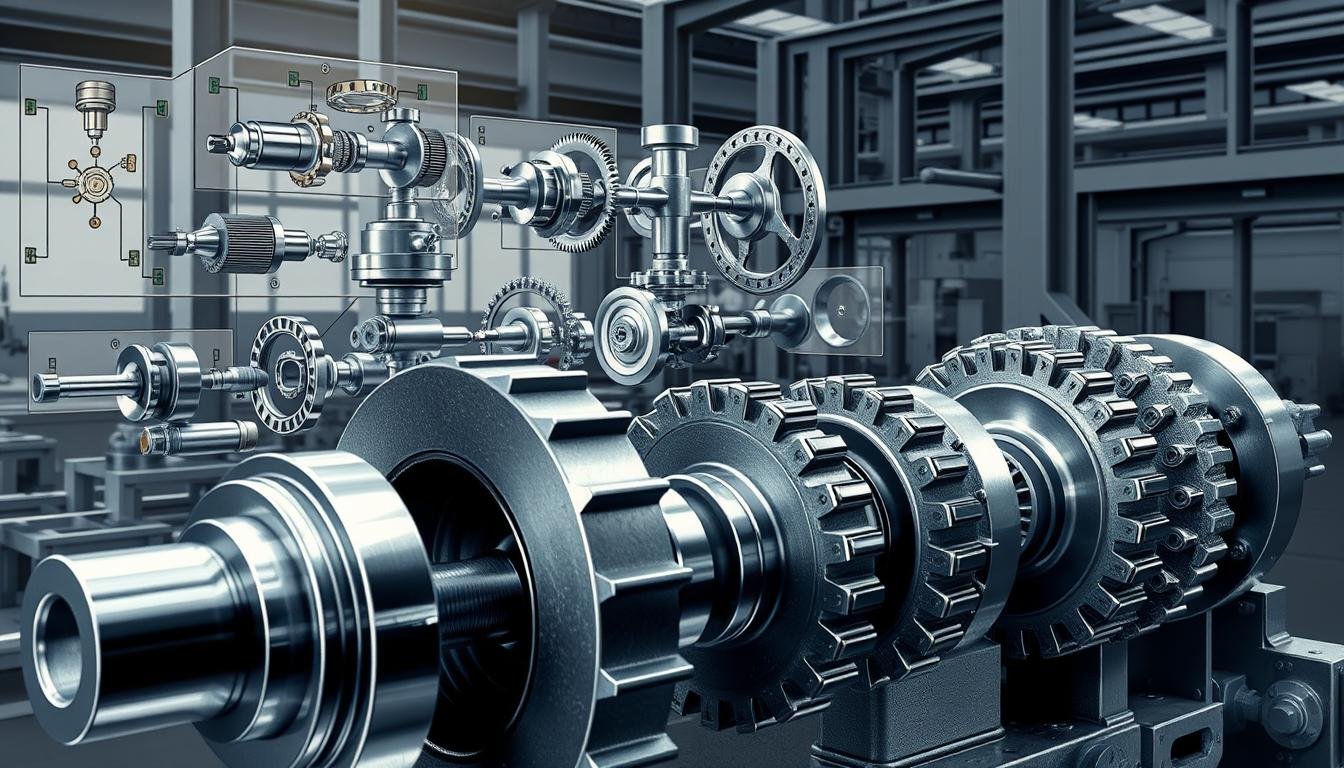In this practical handbook, I’ll show you the essential concepts of mechanical design. It’s a key resource for grasping both the basics and advanced principles of mechanical engineering.
This guide covers everything from the basics to complex topics. It’s designed to give readers a deep understanding of mechanical engineering.
The focus is on practical application. This handbook aims to connect theoretical knowledge with real-world engineering challenges.
Fundamentals of Mechanical Design
Learning the basics of mechanical design is key for future mechanical engineers. It’s the core of mechanical engineering, using engineering principles to find new solutions.
Understanding force, stress, and strain is essential. Force is what pushes or pulls an object, changing its motion. Stress is the material’s resistance to force, and strain is the deformation that results.
It’s important to analyze these forces to design parts that can handle loads without breaking. Knowing how materials react to forces helps engineers avoid failures and improve their designs.
From Concept to Production
The path from idea to product in mechanical design has many steps. These include coming up with ideas, making prototypes, testing, and making the product. Each step is important to make sure the final product works as expected.
In the idea stage, engineers think of and compare different designs. Prototyping lets them test these ideas, getting feedback to improve the design. Testing checks if the design meets standards, and manufacturing makes the final product.
Essential Principles of Engineering Design
Exploring mechanical engineering, I see how vital material selection is. The success of a part or system greatly depends on the materials chosen.
In mechanical engineering, we use three main types of materials: metals, polymers, and composites. Each has its own strengths and uses, fitting different design needs.
Metals, Polymers, and Composites
Metals are strong, durable, and can handle high temperatures. They’re perfect for parts that need to be tough and not bend easily.
Polymers are versatile, resistant to corrosion, and can be shaped in many ways. They’re used in lots of products, from everyday items to industrial parts.
Composites mix the best of different materials. They’re strong, light, and last long. They’re used in high-tech fields like aerospace and cars.
Knowing the good and bad of these materials is key in mechanical engineering. By picking the right material, engineers can make designs better, cheaper, and easier to make.
Modern Tools for Mechanical Engineers
As a mechanical engineer, I use modern tools to make the design process smoother. These tools have changed the game, letting us create complex and precise designs faster.
Popular Software Platforms
Several software platforms are key in mechanical engineering. Autodesk Inventor, SolidWorks, and Fusion 360 are top choices. They help with 3D modeling, simulation, and rendering.
These platforms cut down the time it takes to go from idea to real design. For example, Autodesk Inventor makes changing designs easy. SolidWorks’ simulation tools help with stress analysis.
Finite Element Analysis (FEA) and Computational Fluid Dynamics (CFD) are crucial in mechanical engineering today. FEA simulates how structures behave under different loads. CFD looks at fluid flow and heat transfer.
These tools are key for making designs better and avoiding failures. By using FEA and CFD, engineers can make sure their designs work as expected.
In my experience, adding FEA and CFD to design work has made our designs more accurate and reliable. It shows how modern tools are pushing mechanical engineering forward.
Advancing Your Mechanical Design Skills
As a mechanical engineer, it’s key to keep up with new tech and methods. I look for chances to grow professionally, like online courses or conferences. This helps me improve my skills and know what’s new in the field.
Using mechanical engineering knowledge to solve real problems helps me come up with new ideas. These ideas meet the needs of clients and help the field grow. It makes me a better engineer and helps the field advance.
To get better at mechanical design, start with a solid base in mechanical engineering. Also, keep up with what’s new in the industry. This way, you can handle tough design tasks and bring new ideas to your work.
Tables of contents:
- Introduction
- Materials
- Stress and strain
- Deflection and impact
- Energy methods and stability
- Static Failure Criteria and Reliability
- Fatigue Failure Criteria
- Surface failure
- Shafts and Associated parts
- Bearings and lubrication
- Spur gears
- Helical, Bevel, and Worm gears
- Belts, Chains, Clutches, and breaks
- Springs
- Power Screws, Fasteners, and connections
- Miscellaneous Mechanical components
- Finite Element Analysis in design
- Case Studies in Machine design
Handbook of mechanical engineering design – https://bit.ly/3Gt0Z6D
